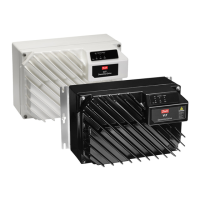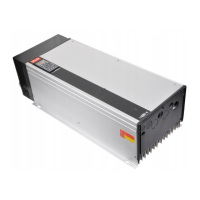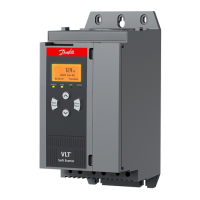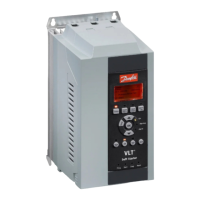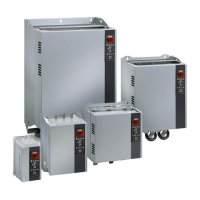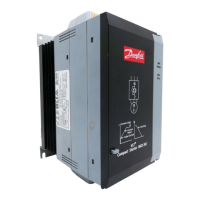2-12 Brake Power Limit (kW)
Range: Function:
NOTICE
If R
br
is not known or if T
br
is
different from 120 s, the practical
approach is to run the brake
application, readout 16-33 Brake
Energy /2 min and then enter + 20%
in 2-12 Brake Power Limit (kW).
2-13 Brake Power Monitoring
Option: Function:
This parameter is only active in frequency
converters with an integral dynamic brake.
This parameter enables monitoring of the power
to the brake resistor. The power is calculated
based on the resistance (parameter 2-11 Brake
Resistor (ohm)), the DC link voltage, and the
resistor duty time.
[0]
*
Off No brake power monitoring required.
[1] Warning Activates a warning on the display when the
power transmitted over 120 s exceeds 100% of
the monitoring limit (parameter 2-12 Brake Power
Limit (kW)).
The warning disappears when the transmitted
power falls below 80% of the monitoring limit.
[2] Trip Trips frequency converter and displays an alarm
when the calculated power exceeds 100% of the
monitoring limit.
[3] Warning
and trip
Activates both of the above, including warning,
trip and alarm.
If power monitoring is set to [0] Off or [1] Warning, the
brake function remains active, even if the monitoring limit
is exceeded, possibly leading to thermal overload of the
resistor. It is also possible to generate a warning via a
relay/digital output. The measuring accuracy of the power
monitoring depends on the accuracy of the resistance of
the resistor (better than ± 20%).
2-15 Brake Check
Option: Function:
Select type of test and monitoring function to
check the connection to the brake resistor, or
whether a brake resistor is present, and then
display a warning or alarm in the event of a fault.
NOTICE
The brake resistor disconnection function
is tested during power-up. However the
brake IGBT test is performed when there is
no braking. A warning or trip disconnects
the brake function.
2-15 Brake Check
Option: Function:
The testing sequence is as follows:
1. The DC link ripple amplitude is
measured for 300 ms without braking.
2. The DC link ripple amplitude is
measured for 300 ms with the brake
turned on.
3. If the DC-link ripple amplitude while
braking is lower than the DC-link ripple
amplitude before braking + 1%: Brake
check has failed by returning a warning or
alarm.
4. If the DC-link ripple amplitude while
braking is higher than the DC-link ripple
amplitude before braking + 1%: Brake
check is OK.
[0]
*
Off Monitors brake resistor and brake IGBT for a
short-circuit during operation. If a short-circuit
occurs, warning 25 appears.
[1] Warning Monitors brake resistor and brake IGBT for a
short-circuit, and runs a test for brake resistor
disconnection during power-up.
[2] Trip Monitors for a short-circuit or disconnection of
the brake resistor, or a short-circuit of the brake
IGBT. If a fault occurs, the frequency converter
cuts out while displaying an alarm (trip locked).
[3] Stop and
trip
Monitors for a short-circuit or disconnection of
the brake resistor, or a short-circuit of the brake
IGBT. If a fault occurs, the frequency converter
ramps down to coast and then trips. A trip lock
alarm is displayed (warning 25, 27 or 28).
[4] AC brake Monitors for a short-circuit or disconnection of
the brake resistor, or a short-circuit of the brake
IGBT. If a fault occurs, the frequency converter
performs a controlled ramp-down. This option is
available for FC 302 only.
NOTICE
Remove a warning arising with [0] Off or [1] Warning by
cycling the mains supply. The fault must be corrected
first. For [0] Off or [1] Warning , the frequency converter
keeps running even if a fault is located.
This parameter is only active in frequency converters with
an integral dynamic brake.
Programming
Operating Instructions
56 Danfoss A/S © Rev. 2014-07-29 All rights reserved. MG37A202
66
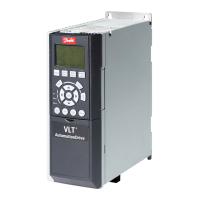
